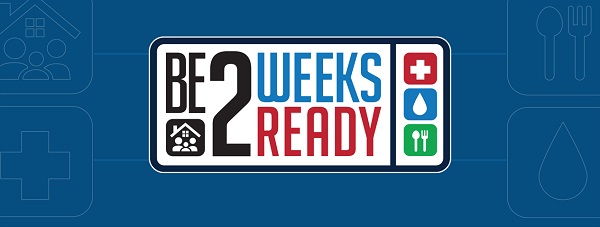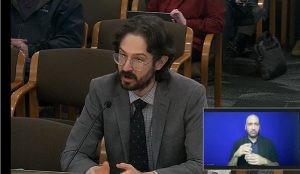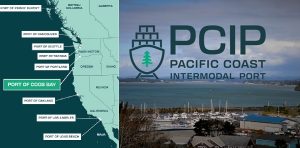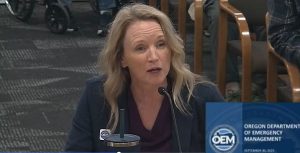Whatever your reason, ‘Be 2 Weeks Ready’ supports emergency preparedness
9 min read
Presenter: Why do you prepare? From the River Road Community Organization, Mysti Frost:
Mysti Frost (River Road): I worry about the state of our dams and sudden failure of our dams due to earthquakes or just neglect.
[00:00:15] Presenter: From Jefferson Westside, Sue Cummings:
[00:00:17] Sue Cummings (Jefferson Westside): Oh, I guess I am concerned about earthquakes and the bridges, you know, all the transportation system possibly falling apart. I think I would turn to my close neighbors and my family if I could get in touch with them.
[00:00:33] Presenter: A participant identified as Bob also spoke up during the Zoom meeting Jan. 16, co-hosted by Dawn Scott and Robert Sprowl of Ready NW Eugene.
[00:00:43] Bob: I am trying to prepare for the big earthquake. Somebody mentioned dam failure, and that’s a kind of a secondary consequence of the big earthquake. And I’d like more information about that. Those are really my main concerns.
[00:01:01] Presenter: Southeast Neighbors board member Lucy Bambrey expressed concern that bridges over 30th East would fall during an earthquake and block a main evacuation route:
[00:01:12] Lucy Bambrey (Southeast Eugene): We as a board for Southeast Neighbors haven’t gotten a real clear picture of what the city would plan for emergency evacuations, especially in the event of an earthquake for the bridges—and there’s at least two of them over 30th Avenue.
[00:01:34] And you have four or five heavily-populated neighborhoods who would want to use 30th Avenue to get out to I-5.
[00:01:42] The last response we had from the city, which was almost two years ago now, was they have a contractor who has large earth-moving or debris-moving equipment, who they would have come out and start working on the bridge.
[00:01:58] And the question we had for them was: ‘Well, where are they located?’ You know, if they can’t get to us for four, five, six days, how does that impact the evacuation area for three or four heavily-populated neighborhoods?
[00:02:12] Presenter: From Friendly Area Neighbors, Carlos Barrera:
[00:02:14] Carlos Barrera (Friendly Area Neighbors): In terms of the dams, that’s a real concern of mine. The Army Corps of Engineers says the reservoir up east of the Eugene Springfield area, that it will survive a major earthquake, but that’s not the whole story. The reservoir is a very large reservoir, and it extends down along kind of like a canyon, and all along that canyon there are high bluffs.
[00:02:41] Just a couple years go, one of those bluffs collapsed on its own and closed the road that goes across to Highway 58.
[00:02:49] In a big earthquake that will last several minutes of shaking, probably a lot of those bluffs will collapse into the reservoir, each one creating a tsunami of their own. And if those tsunamis keep hitting that earthen dam, it could cause it to collapse. And in that case, it will take out all the reservoirs and dammed areas below.
[00:03:13] Presenter: Another participant at the Jan. 16 event, co-hosted by Sandra Bishop and Randy Prince of the Neighborhood Leaders Council, was Fred:
[00:03:22] Fred: I also am concerned about dam failure because I live about one block from the Willamette River.
[00:03:30] Presenter: Whatever you’re preparing for, a new state program can help. It’s called Be 2 Weeks Ready, and offers eight units, each with multiple activities. From the Oregon Department of Emergency Management, Kayla Thompson:
[00:03:42] Kayla Thompson (Oregon Department of Emergency Management): The first unit is ‘Preparing to Prepare,’ and it focuses on mentally preparing for living through a disaster. Many Oregonians have experienced some sort of disaster that’s really impacted them, whether that be a wildfire, an ice storm, flooding, long-term power outage. But then there are people that maybe haven’t experienced something like that.
[00:04:05] So it’s taking that assessment of, ‘Hey, here’s a scenario: It’s three o’clock in the morning. You’re woken up by shaking. Your phone alert is going off, things are falling off the walls: How might you be feeling?’
[00:04:17] And then we ask you questions about your preparedness: ‘Are your big pieces of furniture secured? Do you have extra water? Do you have extra food?’ Just to kind of take an assessment and get you thinking about, ‘Huh, okay, I’m more prepared than I thought,’ or ‘Oh, I never actually thought about this one particular thing.’
[00:04:38] So it’s just that initial assessment that kind of kicks off all of the other units.
[00:04:44] So then Unit 2 is your emergency plan: How are you going to contact your loved ones? How will you know when a disaster is happening? What should you have in your go bag? Things like that. This is a great unit because it covers a lot of things that there’s no cost to do. It just takes a little bit of time.
[00:05:04] And then we have Unit 3, your food plan. Then we go into a water plan. And then Unit 5 is waste and hygiene. And then Unit 6, shelter plan: What are some things that you can do before an emergency to make your living space safer?
[00:05:18] And then we talk about safety and damage assessment immediately following an earthquake, making sure everyone around you is safe, checking for alerts, being aware of aftershocks, checking your home for damages, just kind of a checklist to go through immediately following that.
[00:05:35] And then we talk about first aid. What are some things that you can have in a first aid kit, the Oregon Good Samaritan Law, so how you can not be held liable if you are assisting someone who is in need. And we talk about different first aid classes that you can take: Wilderness First Aid, American Red Cross, how it’s important to know CPR.
[00:05:57] And then the last unit is all about emergency management. What does FEMA do (which is the Federal Emergency Management Agency)? What does OEM do (which is where I work at the state level)? And then what does a local emergency manager do?
[00:06:12] So, it talks about signing up for alerts, following your local emergency management office on social media, and just really being aware of what’s going on in your area.
[00:06:22] And then we also talk about CERT, Community Emergency Response Teams, how to get involved and the role that they play in preparedness. So those are all the units.
[00:06:33] And then we have activities tied to each unit. So that’s a great thing to do if you’re bringing a group together, talk about the material but then do an activity together. It’s a great thing.
[00:06:45] Presenter: All of the program materials are available from the state website for use by individuals, families, or communities. Kayla Thompson:
[00:06:53] Kayla Thompson (Oregon Department of Emergency Management): So how the program works, the toolkit is on our website. Anybody can view it at any time. They can go through whichever units they want to, and it’s just self-paced.
[00:07:03] Then we have the community structure. That is where you have someone who is coordinating outreach, bringing community groups together, and leading in-person meetings, so neighborhood leader, CERT leader, anybody who is in that sort of role.
[00:07:20] So they do a four and a half hour virtual training with me. They learn about the program, how to implement it, how to facilitate the entire toolkit, and then they go back to their community and they say, ‘Hey, who wants to help me share this message?’
[00:07:35] Because the more people that you have to share the message, the more people that you can reach.
[00:07:40] And those people are called community hosts, so, people from that community that want to step up, become familiar with the toolkit and facilitate these in-person discussions about how to be prepared.
[00:07:54] Presenter: In Woodburn, the Community Emergency Response Team members (the CERTs), are serving as hosts and presenting the program. From Woodburn Fire, Uli Reich:
[00:08:03] Uli Reich (Woodburn Fire): Thank you, Kayla, for doing a phenomenal job introducing this program. When Kayla first started—probably within the first two to three weeks—I got on her email and she’s been a phenomenal resource for the CERT program and putting this Be 2 Weeks Ready program together.
[00:08:21] The nice thing about Be 2 Weeks Ready is, once you’ve got it going, you can keep going, and when you’ve done your eight classes, you start on the next round, you start with a new class. And so if somebody misses a unit here or there, not a big deal, you can pick them up later on somewhere along the line, as it fits into your schedule.
[00:08:46] And so the goal is ultimately to have more than just one class happening at one location—that we have classes at different locations so that they’re staggered a little bit and so that if you miss one here this week, you can go over there in a couple of weeks or a week down the road and pick the same class up or figure it out a little bit later on down the road.
[00:09:13] The nice thing is they’re only about an hour long or a little bit less, but they involve the entire family in making sure that when the day comes—it’s not if but when—that everybody knows what to do and how to take care of themselves and the family.
[00:09:33] We started September / October last year. Middle of October was then the first class we went through. We have a very large senior citizens community and we talked to them at their coffee hour in the morning and had people sign up, and we ended up with 13, 13 or 14 people that had signed up for it. And the program hosts, they did a class on Tuesday afternoons at 4 o’clock and they just completed the last unit couple of weeks ago. And out of the 13-14 people that started it, 11 completed the class.
[00:10:25] They’ve all gone through all eight units and have completed probably not all of the activity part that goes with it, but a big chunk of it. And you know, kind of, just like with a lot of other things, it’s—you get out of it what you put into it.
[00:10:46] But the ones that did complete the class were very active participants and are willing to learn and kind of make sure that they themselves and their family were taken care of. But probably the biggest part is getting the word out into the community that this training is available and the benefits that being able to take care of yourself—because 75% to 80% of the help that you’re going to get in case of an emergency comes from friends, families, and neighbors.
[00:11:23] So that’s our next big step, to figure out an effective way to get the word out there, that these are the things that you can do, and here the resources are available. We’re trying to figure out how to get the community as a whole engaged in being emergency-prepared.
[00:11:47] Presenter: How can those interested in Be 2 Weeks Ready learn about classes in their area? Kayla Thompson:
[00:11:53] Kayla Thompson (Oregon Department of Emergency Management): Yeah, so I put the email in the chat: community.preparedness@oem.oregon.gov. If you are interested in seeing if there is a program coordinator near you, just send me an email and then I can get you connected.
[00:12:06] I just wanted to share that we are hosting a community preparedness webinar in April and May, it’ll be two sessions. And the focus is on preparedness for older adults. So the flyer and registration should open up end of February, so I’ll be sure to send that information to Dawn so that she can distribute it out to all of you.
[00:12:26] Presenter: The first Be 2 Weeks Ready host in the Eugene area is Dawn Scott, in Bethel, part of Ready NW Eugene. Given the widespread concerns about upstream dam failures, she shared resources available through Ready NW Eugene:
[00:12:41] Dawn Scott (Bethel, Ready NW Eugene): And I want to encourage you to go to the YouTube channel. Go to YouTube and type in ‘Ready NW Eugene emergency preparedness’ and you’ll see a drop of all of the presentations and zooms that Ready did over the years. And one of those was a very well-presented presentation by the Army Corps of Engineers about the dams in this area.
[00:13:07] Presenter: That YouTube channel also includes a complete version of Kayla and Uli’s presentations about the new program, Be 2 Weeks Ready, available free online for individuals, families, and community groups.
[00:13:20] To find group discussions near you, or to learn how to host sessions with your own community, email Kayla Thompson, community.preparedness@oem.oregon.gov. You can also contact your neighborhood association.






